While the 1950 Bermuda Bowl is officially seen as the start of today's world championship cycle, it actually wasn’t the first match that was advertized as a bridge world championship. That event occured some 17 years earlier, when a match was played between teams representing the USA and England. At stake was the “Charles Schwab Trophy”, offered by the founder of the well-known US investment bank, and the title 1st world bridge champion.
One might even argue that this is not correct, as 3 years earlier there had been an “International Test Match” between the same 2 countries with the same goal: figuring out which country had the strongest bridge team. But that wasn’t billed as a world championship, just as a match between 2 countries.
In 1933, Ely Culbertson was considered the leading authority on the game as well as the main force trying to promote the game. His organization published books, a magazine (“The Bridge World”, still operational today), organized demonstration matches and generated a lot of publicity. They obviously claimed that their team was the best and as the team played the Culbertson system, that system was also superior to any other methods. The British, equally obvious, disagreed and claimed that “any decent British team” would easily defeat the Americans. This discussion led to the test match in 1930, and a few years later, the first world championship in London, July 1933.
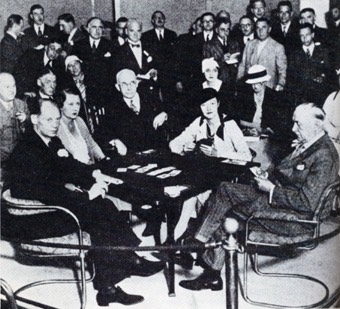
Calling an event a world championship is a great way to promote it, and the Culbertson organization did everything to extract maximum attention from it. That included having the match played at Selfridges, a London department store, where the public could watch the players in action, but also newspaper articles and magazine write-ups, and a book with the official record of the match. The picture on the left shows the players in action. The 4 players at the table are (left to right) US captain Ely Culbertson, Mrs. Doris Rhodes (UK), Josephine Culbertson and UK captain Henry “Pops" Beasley. Between the two ladies, is the referee/scorer for the match.
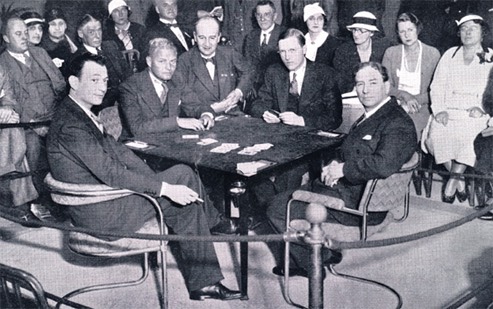
Some years ago, I found second hand copies of both the 1933 and 1930 books. They have been lying on a shelf in my study sometime, with the idea of doing something with them. I guess that time is now. On the right, the other table, the players are, left to right, Michael Gottlieb (US), George Morris (UK), Theodore Lightner and Percy Tabbush. This must be another session, as Mrs. Rhodes is one of the kibitzers.
The 1933 match consisted of 300 hands, played as teams of 4. IMP’s had not been invented, so scoring was by total points, that is, simply add up the points scored by a team in both rooms. Whoever scores the most points, wins. Dealer and vulnerability followed the same pattern as today. There were some differences in the scoring with respect to today, in particular with respect to bonusses and overtricks. Also, honors were still counted, that is, if you had AKQJ of the trump suit, you got 100 points bonus. Another interesting point is that partnerships were far more flexible back then, drawing for partners was very common and both teams fielded about every line-up one could make with 4 or 6 players. The book has the hands, auctions and sometimes the play records of all hands. Comments on the bidding and play were given by Ely Culbertson, “captain of the victorious team”, and modesty is not something in his vocabulary. For people in the Arnhem region: GV can learn a lot from him.
Enough introduction, how about the standard of play? Card play was actually quite good, I didn’t see any obvious errors though not all play records are present or complete, but the bidding appears to be from another planet. One has to remember that most of today’s bidding theory did not exist. For example, Blackwood had not yet invented his convention, instead a tool called the Culbertson 4NT was used, and that resulted in this disaster on board 2.
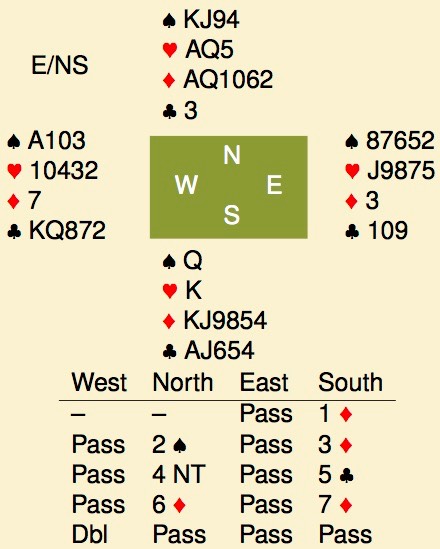
In the closed room, the US team sat NS and bid as follows. 4NT was the Culbertson Slam Convention, described by Ely himself as “a thrilling bid without which winning Contract Bridge is not possible”. The 4NT bid showed 3 aces, or 2 aces with a king in a suit bid. The 5♣ response showed the ♣A. This actually worked quite well as it got NS to the correct 6♦ contract. Why south raised this to 7♦ is beyond me, one would expect that north bid 7♦ with all the aces on board. West was thrilled by this bidding and led the ♠A. In the replay, the auction was a simple but effective 1♦-4♦-6♦. OK, you could easily be off 2 aces, miss a club fit, be cold for 7 and what not, but it worked. 1570 points to the British.
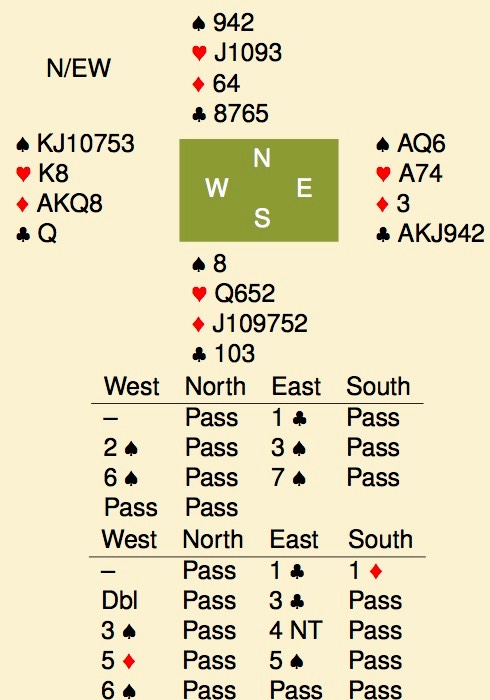
Gambling on grand slams was far more common than it is today, take this board:
7♠ is obviously cold, but I doubt that anybody had any idea if there wasn’t an ace missing. In other room, the auction is also quite interesting. A very light overcall, even by today’s standards, and we see the 4NT convention again. The response showed the remaining ace, but that didn’t excite east.
West did raise, something he could do considering that partner must have 2 aces and a king for the 4NT bid, but 7♠ was missed.
And as slam bidding was a hit and miss affair, doubles and redoubles of slam were also more common. Doubles are, when the opponents don’t know what they are doing, a bit more attractive. They can backfire though, for example on this board.
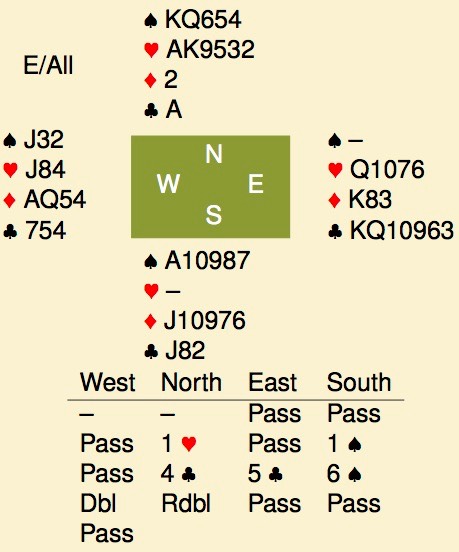
There is no comment about the British bidding other than that it proceeded normally up to the double. Note the 4♣ bid, which looks very modern, but is not discussed. Also note 5♣ from east on a hand where she could not open 3♣ or overcall after north’s opening bid.
Ely Culbertson writes that he hoped that the opponents would get confused after the double, and retreat to a heart or club (sic!) contract. Instead, he got what he deserved. A redouble.
Declarer won the club lead, ruffed a heart, played a trump to the ♠K and ruffed a second heart. That set up the heart suit for a score of 1770.
In the replay, 6♠ was bid but not doubled. That meant 540 points to the English team.
Another thing that had not been invented, was Stayman or any system of responding to NT opening bids. That led to the approach-forcing principle, where players were reluctant to open 1NT but instead opened and bid suits, until it was clear that there was no fit. That frequently led to rebid problems.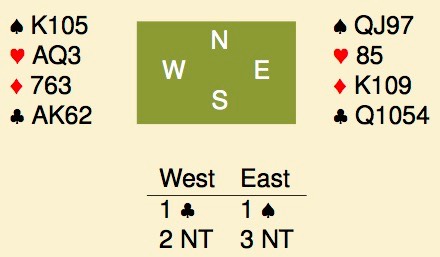
The 3 small diamonds prevented the US west from opening 1NT, in 1933 you needed a stopper in all suits for that. It did create a problem after 1♣-1♠: too strong for 1NT, too weak for 2NT and the diamond problem was still there. Plus, with 2 suits bid, the chances that the ♦-lead will be found actually increases. 3NT was an easy make when north held ♦Axxx and the ♥-finesse was on but that is besides the point.
And finally, a completely bizzare result. It is never a good thing if both pairs of a team play in the same denomination, here the British take this to an extreme:
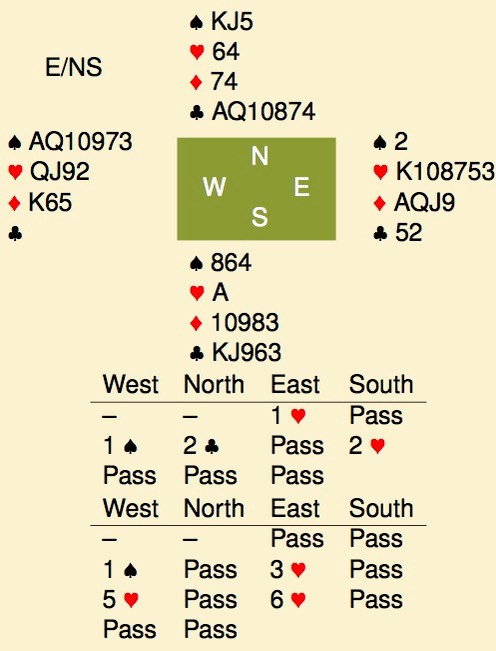
Nowadays, 2♥, as some sort of decent ♣-raise would be a popular bid, but that had not been invented in 1933. Instead, the footnote by Culbertson says that north thought that east had psyched a 1♥-opener and south had the suit, hence the pass in a 2-1 fit.
The defence led a heart to the ace and that was the last trick declarer made. ♣3 back in trick 2, ruffed, ♠A and another spade set up the spade suit. EW now proceeded to take the remaining tricks for down 7.
So, would you you be happy with this result?
In 2016, I actually wouldn’t care too much, it looks like a cold slam for the opponents, so -700 will gain against -980, and if they miss it, -700 against -480 isn’t the end of the world either.
In 1933, things were a bit different. First, EW bid 6♥ and made 12 tricks in a similar way to the other room. So far, so good, but now the book lists the score for 2♥, down 7, as -1750. -1750 in undoubled undertricks, is something I cannot figure quite figure out. If somebody can explain it to me, let me know.
The overall result? The match was played over 300 boards, 6 days of 50 boards each. On day 1, the English team established a lead of about 2000 points. Not much changed on day 2. On the third day of play, the US team slowly came back, and at the half-way point, the match was tied. During the next 2 days, the US team built up a lead of about 10,000 points, the final day was a formality. The end result was a clear US victory, and hence the first world championship went to the US.
The book mentions that more matches would follow “soon”. That prediction was wrong, it’d take 17 years before a next event was organized. In a next episode, something about the 1930 event.
